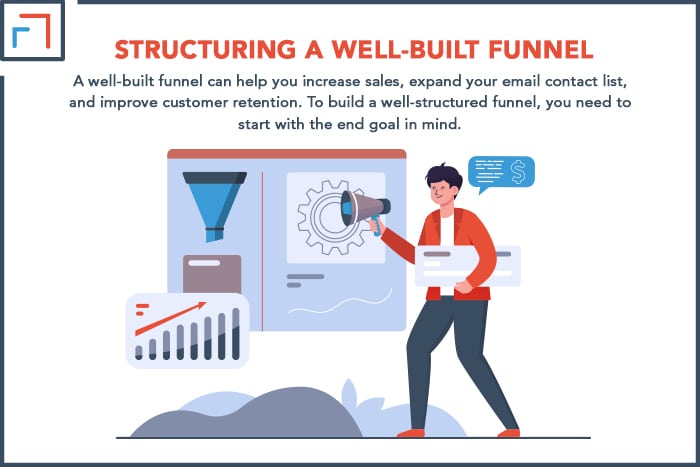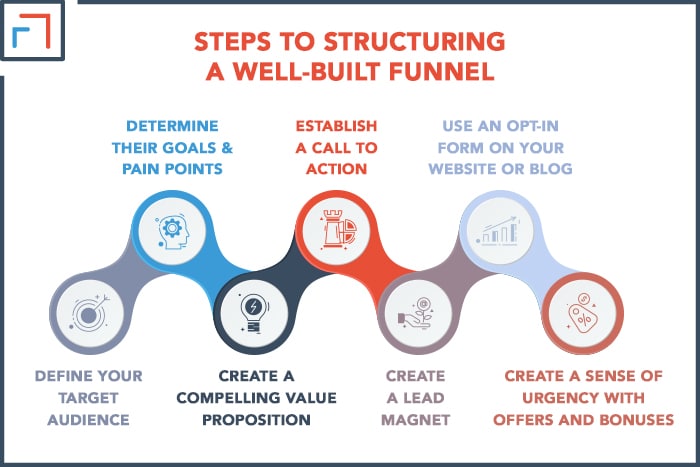A funnel is a marketing process that directs your potential customers to take action. Depending on your goals and target audience, it can be simple or complicated. But how do you properly structure a funnel?
To structure a funnel, you need to know your end goal and work backward. If you want people to sign up for a free trial, you need an email sequence that will convince them to opt in. If your goal is to get them to purchase, you need a landing page with an offer that will compel them to buy.
There is no one-size-fits-all way to structure a funnel. However, there are some best practices you should consider when designing your funnels. Follow along with the tips below to create a great customer experience.
Steps to Structuring a Well-Built Funnel
A funnel is a marketing term that describes the process of converting visitors into leads, leads into customers, and customers into repeat purchasers.
A well-built funnel can help you increase sales, expand your email contact list, and improve customer retention.
To build a well-structured funnel, you need to start with the end goal in mind. What do you want the end-user to do?
Where are they going to go? What actions will they take? Once you’ve answered those questions, it’s time to build your funnel.
The most important thing is to ensure that each step in your funnel is easy for users to follow.
It’s also important to remember that every step should connect directly to your end goals. Here are the steps to creating a great funnel.

1. Define Your Target Audience
The first step to building a funnel is to define your target audience. After all, this is who you are creating the funnel for.
If you know who you’re talking to, this will help determine the content you put into your funnel.
When defining your target audience, ensure that you are specific about who the group is. Research the key demographics and groups you want to appeal to.
You have to know who you’re trying to reach and what their pain points are before you can begin creating content for them.
If you don’t know your target audience, you’ll be wasting time and money by creating content that doesn’t resonate with anyone.
2. Determine Their Goals & Pain Points
After defining the audience, you need to figure out what their goals are and what pain points they may have.
These factors will help you determine which parts of your funnel are most important for each stage of their customer journey.
For example, maybe some customers want to learn more about something specific, so they read an ebook before moving on to the sales page.
Others may just want to sign up immediately because they’ve already decided they want your product or service.
3. Create a Compelling Value Proposition
Your value proposition is what sets you apart from your competitors. It’s your pitch that describes the value you provide for potential customers.
You need to understand why you are better than the competition and address the specific problem your product solves.
Doing this will help you craft a compelling message that resonates with your audience.
The value proposition is the first thing people should see when they land on your site. It should contain a straightforward message that answers the question, “What’s in it for me?”.
If you can’t answer that question in one sentence or less, you need to revise it until you can.
In the area near this statement, you should also include any relevant credentials or endorsements from experts who support your product/service.
These are known as social proof signals. They help establish credibility with consumers while also making them feel more comfortable interacting with the brand.
4. Establish a Call to Action (CTA)
The CTA button is one of the most important parts of your funnel because it prompts people to take action.
You might encourage visitors to click through to another page, sign up for an email list, or download an ebook.
You want the CTA button to be visible on every page of your website so that people can see it no matter where they are in their buyer’s journey.
You can also place it prominently at the bottom of each page so visitors don’t forget about it.
Your CTA encourages people to move on to the next step in the sales process. Create a clear path for customers to take action on the CTA.
If people have to guess, they may become frustrated and will leave your page.
Once a lead is ready to convert, they will be presented with an offer that includes an incentive for taking action (such as a coupon code or free trial).
The goal is for the prospective customer to take this action so that you can capture their information.
Once you have this, you can send messages and nurture them throughout their journey toward becoming a customer.
5. Create a Lead Magnet
Next, create a lead magnet that serves as an entry point into your funnel.
A lead magnet is any piece of content that’s designed to capture email addresses from interested prospects or drive traffic back to your website.
It could be something like an ebook or checklist, but it should always be something that offers real value.
Lead magnets also shouldn’t require a lot of work from the prospect because this hassle defeats the purpose.
6. Use an Opt-in Form on Your Website or Blog for Collecting Leads
You need to get people to sign up for your email list. This can be done by providing a simple form.
If you use automated email services, a person who opts in will be added to your email marketing software and will receive a pre-programmed welcome message.
After someone signs up, they will be taken to another page.
Here, they are asked to give their email address and other information you need to send them emails.
The good news is that you don’t need a website or blog for this — all major email providers have built-in forms that can be placed on any site.
They also have templates that make it easy to create beautiful opt-in forms that match the rest of the site’s design.
7. Create a Sense of Urgency With Time-Sensitive Offers and Bonuses
Once people are on your emailing list, they may not be ready to buy right away — so it’s essential to keep them engaged while they’re considering buying something from you.
You can do this by offering special bonuses or discounts if they buy within a certain timeframe (for example: “Get $100 off if you buy by midnight tonight!”).

Final Thoughts
If you want to build a successful online business, you need to start with a funnel.
However, you also need to remember that there is no perfect funnel that fits every brand. Every business is different, and every industry has its unique features.
This means there is no single best way to build a sales funnel that fits everyone.
However, above are some general guidelines that can be applied universally to any business.
The goal is to get visitors to take the desired action you want, whether it’s signing up for an email list or purchasing a product or service.
